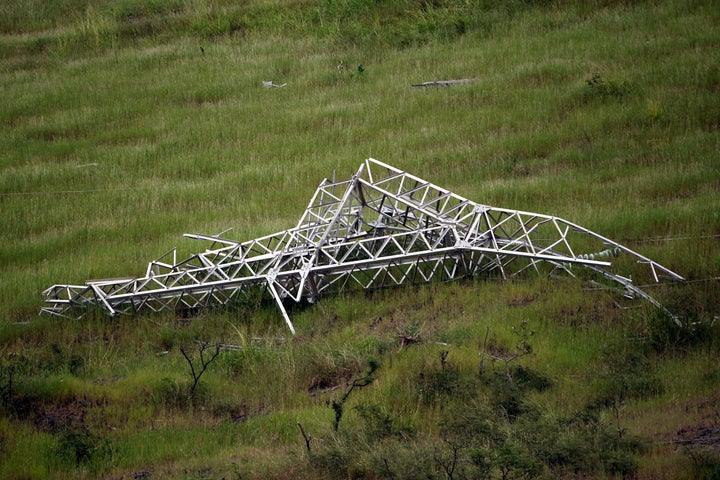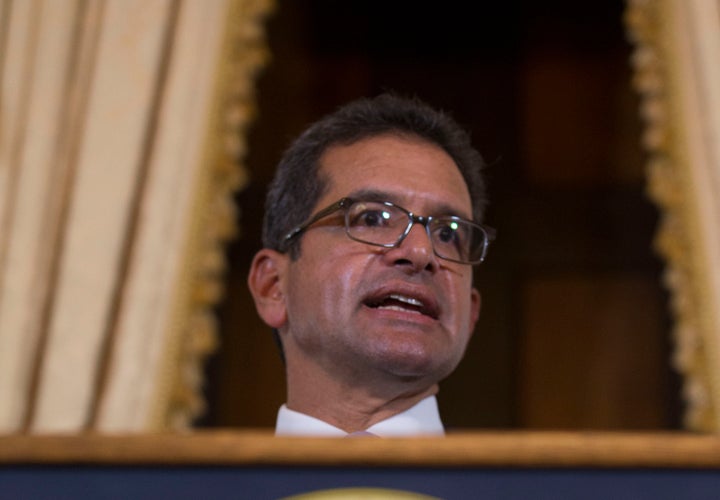Puerto Rico’s newly sworn-in Gov. Pedro Pierluisi is a veteran politician who represented the territory as its delegate in Congress and served as justice secretary.
In between, he worked as a corporate lawyer at O’Neill & Borges in San Juan, where he represented AES Corporation, the coal-fired utility giant accused of polluting groundwater with toxic ash, and the unelected eight-person Financial Oversight and Management Board imposing painful austerity cuts on the island.
Now, if he survives a Senate confirmation vote this week, Pierluisi will oversee the previous administration’s effort to sell off the island’s publicly-owned utility to private companies at the board’s behest.
“This is an outrage,” said Ruth Santiago, a lawyer and community activist in Salinas, one of the cities on Puerto Rico’s south coast that AES’s coal ash pile polluted.
Former Gov. Ricardo Rosselló, who quit amid scandal as half-a-million Puerto Ricans filled the streets demanding his resignation, appointed Pierluisi as his new secretary of state shortly before stepping down Friday. Under the territory’s rules of succession, Pierluisi, 60, became the new governor, though the validity of his oath of office is now facing multiple legal challenges.
Already, demonstrators are calling for his ouster, and, though not legally obligated, he agreed to step aside if the island’s Senate opposes his confirmation in a vote expected this week. His ruling New Progressive Party controls the legislature, but it’s unclear whether Senate President Thomas Rivera Schatz, a rival to replace Rosselló, may rally votes against Pierluisi.
A spokesman for the governor’s office did not return a request for comment on Saturday.
Even if Pierluisi is confirmed, his term expires after next year’s gubernatorial election. Protesters on the island could try to cast him out sooner.

The self-declared revolution on San Juan’s streets came in response to leaked chat logs that showed Rosselló and top Cabinet officials made misogynistic, homophobic remarks and cracked jokes about the bodies of those killed in 2017’s Hurricane María. But the roots of the unrest go back over a decade.
The United States, which conquered Puerto Rico in 1898, industrialized the island in the mid-20th century in large part with tax breaks to mainland firms. In 1996, then-President Bill Clinton phased out the exemptions but for those on municipal debt. As companies left, jobs plummeted and the tax base shrunk, successive Puerto Rican governments issued billions in debt to pay for schools, roads and police.
By 2006, the island fell into recession and faced a budget crisis.
So-called vulture funds, Wall Street firms that buy distressed debt on the cheap and aggressively demand repayment, swooped in as Puerto Rico’s creditors. As a territory, Puerto Rico could not declare bankruptcy the way a mainland municipality like Detroit could. Instead, Congress passed the Puerto Rico Oversight, Management, and Economic Stability Act in 2016 that put in place an unelected Financial Oversight and Management Board. Known locally by the pejorative “La Junta,” the board, given imperial reign over Puerto Rico’s public spending, instituted austerity cuts, slashing retirees’ pensions and closing hundreds of schools.
The devastating 2017 hurricane season ― which left more than 3,000 dead, mostly from lack of access to medicine, clean water and housing ― inflamed Puerto Ricans’ suffering. Rosselló’s inflammatory text messages, coupled with mounting evidence of corruption in his administration, served only as the proverbial match that lit a tinderbox.
Compared to his predecessor, Pierluisi is an even easier avatar for the widely despised oversight board, whose members include, as The Intercept noted, Andrew Biggs — a scholar at the conservative American Enterprise Institute and a former George W. Bush administration official who pushed to privatize Social Security ― and Carlos García, who helped engineer the debt crisis as chief executive of Puerto Rico’s Government Development Bank. The board’s chairman is José Carrión III, an insurance executive and Pierluisi’s brother-in-law. To boot, Pierluisi’s former law firm worked for the board.
“Pierluisi is highly problematic,” said Julio López Varona, a San Juan-based lawyer who works with the Center for Popular Democracy, a think tank. “All of this signals that he would support more privatization and that the current debt deals being negotiated would potentially favor vultures.”
The new governor, he said, “could potentially be worse than Rosselló,” who had been pushing back against his financial overseers to soften the blow to public services and pensions ahead of his planned reelection campaign next year.
“Pierluisi is highly problematic.”
- Julio López Varona, a San Juan-based lawyer with the Center for Popular Democracy
But the oversight board’s push to sell off Puerto Rico Electric Power Authority, the debt-strangled public power company, is moving ahead. Puerto Ricans already pay roughly twice the national average for electricity. Under the privatization plan that Rosselló released, electricity rates will increase 18% to 27 cents per kilowatt-hour in five years and continue to rise, according to an Institute for Energy Economics and Financial Analysis calculation from February.
Pierluisi’s ties to AES are likely to amplify opposition to his government. The Virginia-based company runs Puerto Rico’s only coal-fired power station, and one of its few privately-operated plants, in Guayama. The municipality, with a population of roughly 45,000, already suffered higher than average cancer rates. Between 2004 and 2014, Guayama ranked among the 10 municipalities with the highest incidence of cancer on the island, according to data from the Puerto Rico Cancer Registry that the watchdog Centro de Periodismo Investigativo cited. The neighboring towns of Santa Isabel, Arroyo and Salinas each fell in third, fourth and fifth place on the list.
In an investigation the watchdog site published last year, locals and four experts accused AES’ coal ash pile of “releasing large quantities of chemicals into the groundwater.” The company’s own reports concluded its coal ash piles had “no impact on drinking water” and found “no evidence of impact to human health or the environment.”
But the link between coal ash and water contamination is only beginning to emerge. A study published last year by the North Carolina Institute of Medicine found that more research is needed to determine the cumulative impacts of long-term exposure to coal ash. Some heavy metals and chemicals found in coal ash “can cause cancer after continued long-term ingestion and inhalation,” according to the Agency for Toxic Substances and Disease Registry. In March, the first national study to examine groundwater monitoring data near coal-fired plants found 242 of the 265 plants with monitoring data contained unsafe levels of one or more pollutants found in coal ash.
Before 2017’s storms, the Puerto Rican Board of Environmental Quality ordered AES to secure its hulking black mounds of coal ash with covers and lining. It didn’t. Instead, the hurricanes blew the ash into the air as rains washed it into groundwater, where heavy metals and radioactive materials spread, according to an investigation by the island’s newspaper of record El Nuevo Día. A study AES released last year confirmed the contamination. Since then, AES started shipping the coal ash elsewhere, including 650 million pounds sent to Florida’s Osceola County, where, in a cruel twist, thousands of Puerto Ricans displaced by the storm now live.
Rosselló had vowed in April to halt coal use on the island next year. It’s unclear whether Pierluisi will fulfill that promise.
At a hearing in Puerto Rico’s House of Representatives on Friday, Pierluisi defended his work for AES and argued that coal ash and a construction product made from it called Agremax are, in fact, safe. He admitted to pressuring Puerto Rico Rep. María Milagros Charbonier to vote against a bill that would have put limits on the use of Agremax, which is made from mixing water and ash.

Pierluisi said he was only lobbying for his client. But Charbonier accused him of heavy-handed tactics.
“You called me to tell me that the project was unconstitutional,” Charbonier said, according to El Nuevo Día.
If AES continues to burn coal, replenishing the existing piles on the island, it could face even less accountability for its pollution. Last week, the Environmental Protection Agency proposed loosening rules on coal ash, scrapping a blanket rule that requires utilities to prove piles of at least 12,400 tons are safe. The move comes a year after AES’s Puerto Rico subsidiary petitioned the EPA to weaken regulations on groundwater monitoring around coal ash deposits and raise the limits on lead, cobalt, lithium and other metals in aquifers. The petition is still pending.
Judith Enck, Puerto Rico’s former EPA regional administrator, said the AES plant is a “major problem on the island.” She urged Pierluisi to halt any further coal- or biomass-burning at the AES plant.
“Pierluisi should, at the very least, recuse himself from any decisions involving AES,” Enck said by email Saturday.
The protesters in Puerto Rico’s capital, meanwhile, seem determined to keep the new governor’s work for AES front of mind. On Sunday morning, demonstrators are scheduled to rally in front of La Fortaleza in Old San Juan, according to the news website Voces del Sur.
The planned protest chant: “Say no to the son of coal.”
UPDATE: Aug. 8 ― Pierluisi resigned this week after Puerto Rico’s Supreme Court ruled that his oath of office was invalid. AES responded to HuffPost’s article after publication with the following letter:
CLARIFICATION: Language in this story has been reworded and updated with additional information regarding pollution and cancer rates in the areas surrounding AES’s plant.
